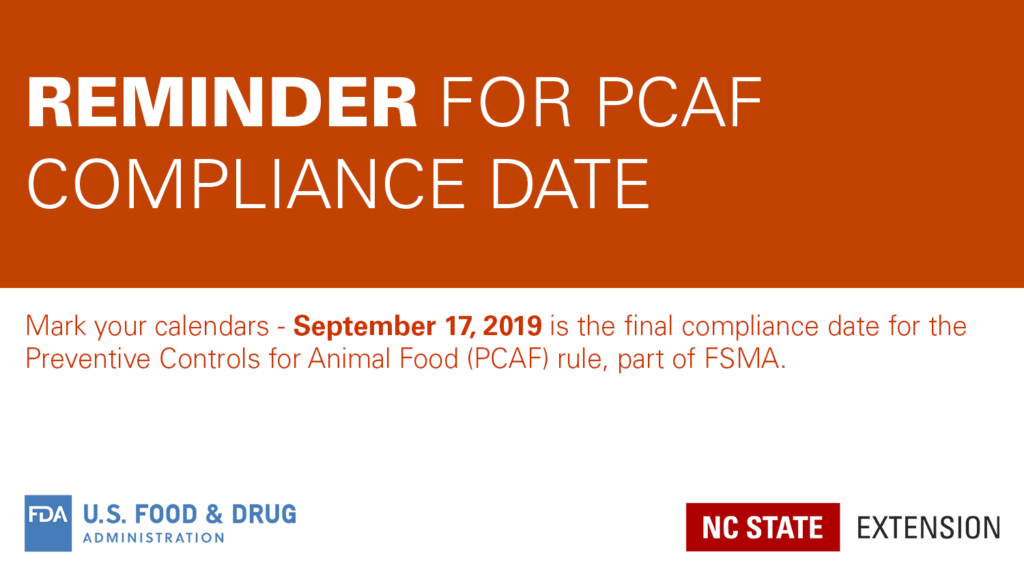Compliance Date for Preventive Controls for Animal Food Approaching
go.ncsu.edu/readext?619963
en Español / em Português
El inglés es el idioma de control de esta página. En la medida en que haya algún conflicto entre la traducción al inglés y la traducción, el inglés prevalece.
Al hacer clic en el enlace de traducción se activa un servicio de traducción gratuito para convertir la página al español. Al igual que con cualquier traducción por Internet, la conversión no es sensible al contexto y puede que no traduzca el texto en su significado original. NC State Extension no garantiza la exactitud del texto traducido. Por favor, tenga en cuenta que algunas aplicaciones y/o servicios pueden no funcionar como se espera cuando se traducen.
Português
Inglês é o idioma de controle desta página. Na medida que haja algum conflito entre o texto original em Inglês e a tradução, o Inglês prevalece.
Ao clicar no link de tradução, um serviço gratuito de tradução será ativado para converter a página para o Português. Como em qualquer tradução pela internet, a conversão não é sensivel ao contexto e pode não ocorrer a tradução para o significado orginal. O serviço de Extensão da Carolina do Norte (NC State Extension) não garante a exatidão do texto traduzido. Por favor, observe que algumas funções ou serviços podem não funcionar como esperado após a tradução.
English
English is the controlling language of this page. To the extent there is any conflict between the English text and the translation, English controls.
Clicking on the translation link activates a free translation service to convert the page to Spanish. As with any Internet translation, the conversion is not context-sensitive and may not translate the text to its original meaning. NC State Extension does not guarantee the accuracy of the translated text. Please note that some applications and/or services may not function as expected when translated.
Collapse ▲The final compliance date for the Preventive Controls for Animal Food (PCAF) rule, part of the Food Safety Modernization Act of 2011 (FSMA), is
SEPTEMBER 17, 2019
The FSMA was signed into law in January 2011 by President Barack Obama to reform the food safety system in America to encourage facilities to be proactive, rather than reactive to food safety issues. The final rule was published in September 2015 and in July 2016, the Food Safety Preventive Controls Alliance (FSPCA) began providing training on the PCAF rule.
The compliance dates for FSMA have been staggered over the course of the past three years, providing one year between compliance with Current Good Manufacturing Practice (CGMP) and Hazard Analysis and Risk-based Preventive Controls. Compliance dates depend on the size of the business, determined by the number of employees or sales.
With the final compliance date quickly approaching, it’s important for facilities to be aware of Subpart B: Current Good Manufacturing Practice, Subpart C: Hazard Analysis and Risk-Based Preventive Controls, and Subpart E: Supply Chain Applied Controls requirements.
All facilities required to comply with Subpart C should have a written and signed food safety plan in place by September 17. Facilities should also be prepared for CGMP and Hazard Analysis inspections.
According to the FDA, FSMA inspections will be starting in October 2019. These inspections could last several days and may be completed by multiple investigators. It is likely that facilities will be inspected for compliance with multiple regulations in addition to FSMA, such as Medicated Feed CGMP, Veterinary Feed Directive (VFD) and Bovine Spongiform Encephalopathy (BSE).
See the requirements of the food safety plan.
Read about recent state and federal investigator commentary during a recent talk at the annual Association of American Feed Control Officials (AAFCO) Food Safety Modernization Act Conversation workshop.
Contact Marissa Herchler with any questions regarding the Preventive Controls for Animal Food rule.



